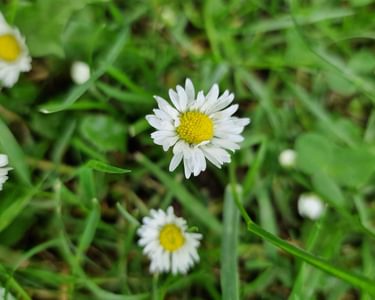How to grow a greener lawn

Nothing quite swells your status in a street like a well-manicured lawn. You only have to look at the meticulously preened lawns of Britain’s historic stately homes to understand they’ve long been a symbol of wealth and power.
With the advent of the mower in 1830, lawns soon gained mass appeal and perpetuated by images of clipped cricket greens and lawn tennis courts, they’re now considered an almost compulsory element in a garden. One study, published in the Urban Forestry and Urban Greening journal, suggests 70% of urban green areas globally are blanketed in turf.
But has our need for keeping up appearances gone a blade too far? One in ten homeowners are now replacing their garden's natural lawn with artificial grass, according to an Aviva study, with a further 29 per cent planning or considering making the swap to plant-free plastic.
With ‘Oasis’, ‘Savanna’ and ‘Fauna’ among the names for these rolls of rootless grass, you’d be fooled into thinking these carpets of green are also good for your garden. But while many artificial grass manufacturers push the idea of them being better for the environment due to the fact they don’t need mowing, watering or fertilising - the only thing green about them, is their colour.
The environmental impact of artificial lawns
The footprint of fake grass starts even before installation. Here’s some reason why they’re a poor choice:
- Most are made from polypropylene or nylon (polyamide), which can belch pollution as they are being manufactured.
- Synthetic sward also degrades, shedding microplastics into the soil and our waterways. And with the average shelf life around 15 years, most fake grass will end up in landfill because it cannot be recycled.
- Synthetic turf provides no food for insects or birds because it restricts access to the soil. Below ground there is less worm and micro-organism activity. Above ground, there are no habitats for insects, and birds cannot feed on worms or rustle through leaf litter for grubs.
- Far from being low-maintenance, artificial lawns need to be kept clean, and because they’re outside they absorb all kinds of animal and bird droppings. Mowing is often replaced by detergents, vacuuming and leaf blowing.
- According to a Kings College report in 2021, plastic turf also increases the chances of flooding. A series of tests revealed that more than 50 per cent of rainfall runs straight off some types of artificial lawn, whereas living lawns absorb almost every drop.
- Plastic grass also contributes to global warming due to the way it absorbs more radiation and reaches significantly higher temperatures. This overheating makes them almost unusable in hot summers - and possibly a danger to health.
Is a grass lawn more eco-friendly?
While a grass lawn is a better choice, the benefits are more nuanced. If you hanker after weed-free, slick sward then this will inflict its own unfriendly footprint. The manicured look often relies on an abundance of chemical fertilisers and pesticides, as well as watering in dry weather and the use of polluting mowers.
The key to a more sustainable approach to turf, is less intensely managed lawns with longer patches and more diverse groundcover plants. These so called ‘lazier lawns’ act as natural air and water filters, trapping pollutants and run off, and providing shelter and sustenance for insects, worms and birds, such as blackbirds and starlings. They also help mitigate the heat island effect in urban areas, transpiring and evaporating water to cool the surrounding air.
Top tips for greening up your lawn
- Incorporate beneficial plants. Incorporating more than just rye grass into your lawn is a great first step in making it more enticing to nature. This can be as simple as allowing plants we normally consider ‘lawn weeds’ such as dandelion, speedwell and buttercups to grow naturally. Moss can also provide a fluffy shelter for invertebrates and nesting materials for birds. Clover adds a pretty texture and makes the lawn more drought resistant. Read more about other alternative plants for lawns.
- Leave longer patches. No Mow May might be a one-month initiative but consider relaxing your mowing regime for a couple of months a year and see what pops up. Your children will love getting their magnifying glasses out and seeing what interesting plants and bugs they can find. Or mow your lawn on a higher setting, around seven centimetres, and this lengthier foliage will provide shelter and foraging spaces for animals such as frogs and hedgehogs, while shorter grass is perfect for birds. Grass lawns can absorb carbon, but they also release it when mowed or fed.
- Don’t feed or water. Feeding encourages thicker grasses that shadow out more beneficial plants and flowers. And as grasses are very deep rooting, they will survive for a long period without watering even if they appear to have turned brown. This is due to the fact the part of the plant responsible for growing organs and leaves, is at the base of the plant, which means they can be cut, grazed and even set on fire, but continue to grow. Your lawn will more than likely recover after drought so use precious water for something more important.
- Maintain your lawn. Care for your lawn through the seasons to nip problems in the bud quickly, and you will be less likely to reach for the quick-fix fertilisers or, worse still, pesticides. Find more advice here.